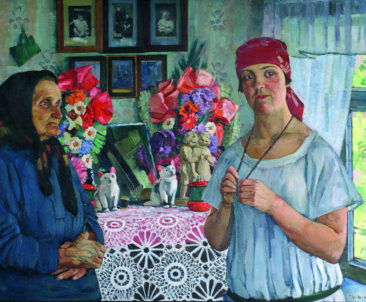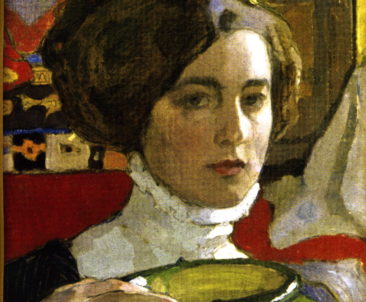
24.10.1875 – 11.04.1958
October 24, 1875 was born a famous painter, theater artist, art critic and teacher Konstantin Fedorovich Yuon. He was the third son of the director of the insurance company Theodore Yuon, whose ancestors were from Switzerland. The artist’s mother was fond of music, however, the fine art attracted Constantine more strongly, at the age of 17 he entered the Moscow School of Painting, Sculpture and Architecture. His teachers were such well-known artists as the Peredvizhniki as K.A. Savitsky, N.A. Kasatkin, A.E. Arkhipov.
After graduation, Konstantin Yuon worked in the studio of the famous Valentin Serov. From 1900 to 1917 years. Konstantin Fedorovich supervised his own workshop. Among his pupils – Vera Mukhina, Vladimir Favorsky, Alexander Kuprin.
In 1900, Konstantin Yuon married a peasant woman from the Ligachevo village near Moscow, Claudia Nikitina, with whom the artist lived a long and happy life.
After the marriage, the artist often lived and worked in Ligachevo, and the village was a frequent plot of his paintings. Despite the fact that the artist painted both portraits and historical scenes, participated in the design of the performances, his landscape remained his favorite genre.
Konstantin Yuon is an outstanding colorist. A vivid example of this is the picture kept in the Voronezh Regional Museum. I.N. Kramskoy “The outgoing province.” Cheerful bright colors, balanced composition create a feeling of light sadness over the rapidly passing time.
In 1943 Konstantin Yuon was awarded the Stalin Prize, in 1950 he was awarded the title of People’s Artist.
In 1948-1950 Konstantin Yuon headed the Research Institute of History and Theory of Fine Arts of the Academy of Arts of the USSR. In 1952-1955 – taught at the Moscow State Art Institute. IN AND. Surikov. Artist until the last day led an active creative life.
Konstantin Yuon died on April 11, 1958 at the age of 82 years.

Elena Andreevna Kiseleva was born in Voronezh, in the family of a mathematician-teacher, later widely known author of textbooks on algebra and geometry. Initial art skills were awarded to the Voronezh Free Drawing School. Having graduated from the Voronezh Mariinsky Gymnasium with a gold medal, Elena Kiseleva first entered the mathematical department of the Bestuzhev Courses in St. Petersburg, and then, in 1898, at the Higher Art School of the Academy of Arts, and from 1900 to 1907 studied at Ilya Repin’s workshop. Creations Kiseleva academic period – portraits of Voronezh peasant women, numerous picture sketches, very close in a picturesque manner to the traditions of peredvizhnichestva. Subsequently, the name Kiselyov Repin named among the most gifted women of the Academy.
After graduating from the Academy of Fine Arts, Elena Kiseleva continued her studies in Paris, becoming the first pupil of the Academy to receive the right to travel abroad abroad. In Paris she became acquainted with various trends and trends in contemporary art, which were reflected in the picturesque composition of works performed in France.
The pre-revolutionary decade was the most fruitful period in the work of Elena Kiseleva. At this time, her works found expression of the exquisite, inherent in the style of modern decorativeness.
A special place in the work of Elena Kiseleva was always occupied by portraits. The artist managed to masterfully transfer the psychological state of her models, create a history around them, reflecting their life path. In 1913, in a Paris workshop she painted a portrait of Marousia, which today the inhabitants of the capital of the Chernozem region are lovingly called “Voronezh Gioconda.” Transferred in 1929 as a gift to the Voronezh Museum by the artist’s mother, this portrait for Kiseleva herself was a kind of tuning fork, an aesthetic criterion in the evaluation of her own works.
In 1918, Kiseleva moved to Odessa and then, three years later, together with her husband, Anton Bilimovich, the former rector of Novorossiysk University and the trustee of the Odessa Academic District, to Belgrade, where she spent the rest of her life. In Serbia, and today with great respect for the works of Elena Kiseleva. The artist actively participated in the cultural life of Belgrade until the death of her son, after which art forever left.
At some point, the name of Elena Kiselyova in Russia was almost forgotten. The leading researcher of the Voronezh Art Museum Margarita Ivanovna Luneva played a leading role in revealing the biographical circumstances and studying the creative heritage of Kiseleva. Her research and correspondence with the artist made it possible to clarify the history of the creation of a number of works, and her publications are still the most comprehensive source in the study of Elena Kiseleva’s work.